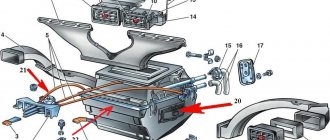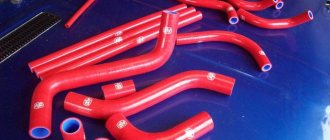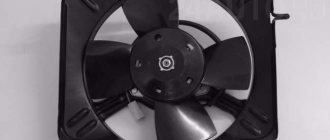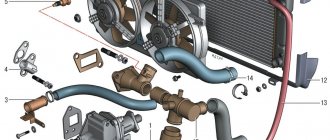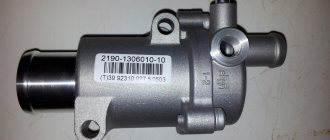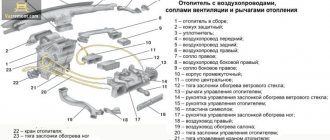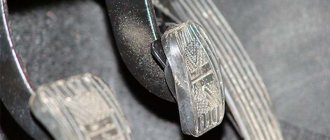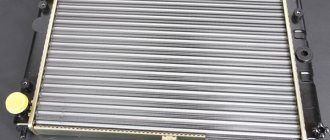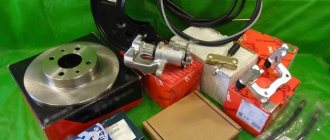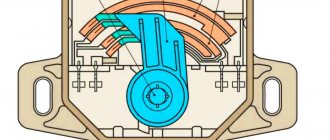The presence of air in the car's cooling system causes problems with engine overheating and ineffective operation of the interior heater. This article will present 4 methods by which it will become clear how to expel air from the cooling system of a VAZ 2114. The methods for solving the problem described in this article can be used on the entire family of first and second Samaras.
Useful video:
Signs of airing
The problem of air getting into the cooling system does not appear unnoticed. An increase in engine temperature, poor performance of the stove, and the presence of antifreeze leaks are clear signs of an airy system. Signs of an air lock in the VAZ 2114 cooling system:
- Engine overheating due to uneven cooling;
- Dips when pressing the gas pedal;
- No heating from the stove.
Violation of the temperature regime of the engine leads to its accelerated wear. Breaking the cylinder block gasket and getting antifreeze into the oil is not the worst scenario for such a malfunction. Engine wedge and the appearance of cracks in the cylinder block often occur precisely because of overheating, so you should carefully monitor the readings of the temperature sensor on the dashboard.
There are several reasons for problems with airing:
- A non-working thermostat jams, causing the temperature of the antifreeze to rise and it gradually evaporates;
- Leaking pipes;
- A breakdown in the cylinder block gasket leads to leakage of antifreeze into the cylinders (white steam from the exhaust pipe and the presence of an emulsion instead of oil is a sign of a broken gasket);
- Defective pressure relief cap on the expansion tank.
In any case, the problem with the air lock must be corrected promptly. Methods to expel air from the VAZ 2114 cooling system are described below.
Helpful : What to do if the heater blows cold air onto the windshield?
Causes of air locks
Air is characterized by relatively low thermal conductivity, and by itself it is rarely used as a cooling agent (the exception is radiator blowing, but the reasons here are prosaic - the complete absence of energy costs). But its danger when mixed with technical fluids lies not so much in the reduction of heat capacity, but in the formation of air pockets, which, accumulating at the highest points of the line, prevent the free flow of coolant.
When does air leak into a sealed engine cooling system? There may be several reasons:
- depressurization of the system is a violation of the integrity of the connections of pipes, tubes, hoses at the point of their attachment to the fittings, which leads to such a phenomenon as suction of outside air. This can happen as a result of overheating, accidental mechanical impact, inept driver actions, or due to natural wear and tear. Separately, it is worth mentioning cases where loss of tightness occurs due to prolonged exposure to low pressure in the system, observed at the surface of the pipeline walls during coolant movement;
- Many drivers don’t even realize that when replacing or adding antifreeze, if done quickly, a large funnel is formed that does not allow air to escape. As a result, a noticeable amount of air enters the system, which threatens the formation of traffic jams with all the ensuing consequences. Therefore, the recommendation to pour antifreeze in a thin stream, regardless of time, remains relevant for a significant part of car owners;
- problems with the functioning of the air valve. A pump is used to circulate coolant in the system, but the pressure created is not static: due to the heating of the liquid, the pressure increases in certain sections of the line, and decreases in the area of the radiator. This is, in principle, normal. But in some cases, the area of high pressure reaches the expansion tank, the air in which is compressed, and the valve in the tank lid bleeds it out. At reduced pressure, the reverse process occurs - air is sucked in. But if the valve is stuck, then it only works in one direction. This is fraught with the accumulation of air mass, which is simply forced to move on through the pipelines, mixing with the coolant;
- air can penetrate into the CO through a leaky pump seal, as well as through the fiber if it has end-to-end mechanical defects;
- antifreeze leaks through the connections of hoses, pipes and both radiators may not lead to air entering the system through them, but in such cases the volume of coolant decreases, which automatically leads to an increase in air volume (through the expansion tank). If the radiator is clogged, the engine begins to overheat, and collectively this leads to the formation of traffic jams;
- Violation of the integrity of the cylinder head gasket is another common cause of antifreeze leakage penetrating into the cylinders, as a result of which the volume of coolant decreases, and you already know the consequences of this phenomenon.
By the way, when antifreeze gets from the cylinders into the crankcase and accumulates there, checking the oil level with a dipstick may show its increase. If coolant enters the exhaust system, this can be detected by a change in the color of the exhaust from transparent to white.
This problem should not be treated as a minor issue. Troubles if airiness and the causes of its occurrence are not eliminated may be too serious. A change in the normal circulation of antifreeze along the main line is only the first sign, but this is where problems with heat removal from the power unit begin. Since coolant does not enter the radiator due to air locks, it does not cool and flows into the engine while still hot. The latter begins to overheat, worsening its dynamic performance.
A secondary manifestation of CO airiness is deterioration in the operation of the cabin heater, since antifreeze does not reach it, and the operation of the fan does not improve the situation - cold air continues to flow into the cabin.
Method 1
When starting to consider ways to remove an air lock from the cooling system of a VAZ 2114, the first step is to consider the easiest option. This method is based on physics. Because air in a liquid always tends to the top, you can put the front of the car on a hill, then unscrew the cap of the expansion tank and wait for the air to come out. Also, when lifting the car, you need to warm up the engine.
Adding gas will speed up the process of air leaving the system. Also, in the process of removing the plug, you need to switch the stove to the hottest mode and turn on the first fan speed. This method does not always help, because... it all depends on the location of the plug in the circuit. If there are leaks from the pipes or from under the thermostat, this method will only give a temporary effect, because the circuit will become leaky and will take in air again. Since it is not always possible to remove an air lock from the cooling system the first time, you can use other methods.
How to properly remove an air lock from the cooling system?
According to the law of physics, air accumulates in the highest place. In a car, the highest link in the coolant chain is the throttle body. That is why the air must be removed from there. There are several ways to get rid of an air lock.
Here is the first one. If you have a 1.6 liter engine, then:
- First of all, we remove the plastic cover on the engine - unscrew the cap on the engine to fill the oil, and then pull out the entire cover. It is seated on rubber seals.
- After removing this plastic screen, screw the oil cap back on to prevent dirt from getting into the crankcase.
- We find the heating pipes for the throttle assembly (there are 2 of them), see the figure. Pick up any phone.
- Next, unscrew the cap of the expansion tank (coolant reservoir) and cover the neck of the tank with a clean rag.
- We begin to blow into the tank with liquid. We blow until all the air comes out of the hose and antifreeze flows out.
- We quickly put the tube back on and tighten it with a clamp so that no air gets in.
Method 2
A more sophisticated and effective way to get rid of a traffic jam is to create pressure in the system by the owner of the car himself. Briefly, the essence of the method is the following steps:
- Unscrew the engine oil filler cap;
- Remove the rubber gasket from it and return the cover to its place;
- Next, unscrew the cap from the expansion tank;
- Release one of the tubes leading to the throttle from the clamp and remove it from the metal pipe;
- Cover the neck of the tank with your mouth and blow into it, creating pressure in the circuit;
- After the antifreeze begins to flow out of the pipe without bubbles, put it in place and tighten it with a clamp;
- Reassemble the removed parts in reverse order.
This method may seem unsafe, because... There is a risk of inhaling antifreeze vapors when blowing air, but at low temperatures this procedure is safe. If the cooling system is still not free of the plug, use the following method.
How to remove air from the cooling system
There are three most well-known and quite effective methods with which it is possible to get rid of air from an element in the cooling system.
The first method has proven itself well in relation to cars of the VAZ family. Sequencing:
- it is necessary to remove all attachments from the engine that block normal access to the expansion tank;
- disconnect the pipe designed to heat the throttle assembly (reverse or direct - it doesn’t matter, they both lead to the highest point of the cooling system);
- unscrew the tank cap, thereby creating a small excess pressure in the system, sufficient for all excess air to leave the system through the dismantled pipe;
- We begin to blow vigorously into the pipe disconnected from the carburetor, wait for the moment when coolant flows out of the pipe, and immediately install it in place, making sure to fix it with a clamp connection (otherwise the air will have time to get back into the line);
- screw on the RB cover;
- We install previously dismantled hanging elements in their original places.
As you can see, this is a fairly simple method of removing air from the cooling system, which, unfortunately, is not applicable to all cars.
But you can remove the air lock from the cooling system in almost the same way, but more universal, since it is suitable for both carburetor and injection car models.
Its essence lies in the same actions, with the exception of dismantling the pipe, which can be removed by any that comes into the expansion tank. In this case, there is no need to unscrew the RB cover, and the engine must be in a warm state. All other steps are identical. But when operating with the pipe, you should be as careful as possible, since the temperature of the antifreeze can reach 90°C, and you risk getting burns if handled carelessly.
We’ll also tell you about the third method of pumping air from a car’s cooling system, which is common among experienced drivers. To do this, the vehicle must be placed on a hill with a slight gradient so that the front part is at the very top (strictly speaking, we need to ensure that the radiator cap rises above all other components of the cooling system).
Don't forget to secure the car with the parking brake and wheel chocks, since we will need a running engine. It needs to be warmed up for about 15 minutes, then open the hood and unscrew the radiator cap in sequence and then the expansion tank.
After this, you need to press the accelerator pedal, and then add coolant to the radiator neck. If there is air, it will appear as bubbles coming out of the neck. This manipulation must be done until all the air has been removed.
It is advisable to set the heater to maximum heating mode. Wait until the thermostat opens the damper. If hot air comes into the cabin, it means everything was done correctly and we got rid of the airiness.
On machines equipped with automatic equipment that independently activates the CO fan, it is possible to bleed air from the cooling system without re-gassing. Just wait for the fan to turn on, which will increase the pressure in the system, and this will be enough to solve the problem. However, it is still necessary to add coolant, otherwise airing will manifest itself again.
Method 3
The troubleshooting algorithm looks like this:
- Warm up the engine to operating temperature without allowing the cooling fan to operate;
- Similar to the second method, remove one of the pipes from the throttle;
- When you remove one of the tubes, air will come out, after which antifreeze will begin to flow out. At the same moment, place the tube in place and tighten the clamp.
Understanding how to remove air from the cooling system on a VAZ 2114 allows you to eliminate the problem of sudden engine overheating due to a traffic jam anywhere. It is enough to have a screwdriver to unscrew the pipes from the throttle and work on eliminating air can begin.
How to remove a plug from the cooling system
Today we will talk about how to independently remove an air lock from the cooling system of Lada cars with an electronic gas pedal.
A plug in the cooling system is an accumulation of air that is in the coolant. It impairs the functioning of the cooling system.
Most often, an air lock occurs after draining the coolant from the car - when replacing it, servicing the cooling system, etc. When pouring coolant back through the expansion tank, the air that has entered the system does not have time to escape and remains in the form of bubbles in the liquid. On Lada cars, the air lock most often remains in the heater, since its radiator is located above the level of the expansion tank.
On older cars, without E-gas, it was quite easy to remove the airlock. In these cars, the throttle valve was heated by coolant. Since the throttle valve is located high, it was enough to disconnect the thin coolant supply hose from the throttle before filling in the coolant and slowly fill the expansion tank. At the same time, the air came out through this thin hose. As soon as coolant began to flow through it, filling the system could be stopped. An air lock rarely remained with this method.
But in the case of E-gas, the situation is different. On Lada cars with an electronic gas pedal, the throttle valve is no longer heated, and therefore there is no hose either. How to be?
To remove air from the cooling system on cars with an electronic gas pedal, you need to make sure that the expansion tank is higher than the heater core. To do this, you can use a lift at a car service center, or you can simply drive the front of the car onto a steep hill.
After this, you need to open the hood, get behind the wheel and keep the engine speed at 2-3 thousand.
After warming up the engine until the fan operates, you need to get out of the car and carefully open the expansion tank cap.
In this case, you will see air bubbles coming out of the system - this is an air lock.
After turning off the fan, you need to repeat this operation until air stops escaping from the system. After this, you can tighten the expansion tank cap and turn off the engine. If the air lock has come out, no gurgling sounds should be heard in the heater, and hot air should come out of the deflectors when the heater is turned on.
How long does it take for a car to warm up to operating temperature? You probably have an air lock in the cooling system. The phenomenon is quite common and unpleasant. The consequences are increased fuel consumption, poor heating of the interior by the stove, increased wear of engine parts. We will tell you how to remove air from the VAZ 2114 cooling system and forget about these problems.
Method 4
The most effective, but labor-intensive method to fix the problem is described below. The only thing additionally required is a container of antifreeze.
- First, warm up the engine to operating temperature;
- Raise the front of the car so that the radiator cap is the highest point;
- Remove one of the pipes from the throttle and dip it in a container with antifreeze;
- Then, simultaneously with adding gas, add antifreeze to the tank;
- As soon as the bubbles in the container disappear, you can put the pipe back in place.
You need to understand that an air lock in the cooling system over time can cause sudden overheating of the engine and complete failure of the stove. You can ventilate the circuit yourself using the methods described above, but you should regularly check all connections and the tank for leaks. If even after removing the plug the engine continues to heat up, check the condition of the thermostat. Also, to prevent leaks, change the clamps on the pipes. Their rare use leads to relaxation of the pipes to the radiator, expansion tank and thermostat. For reliability, you can use joint sealant on the last element.
How to remove an air lock on a VAZ with electronic (e-gas)?
Since there is no throttle valve cooling system, you need to bypass this unit. Here you can also set the car up.
I hope that these three methods will help you solve the problem, and that you have found all the answers to your questions on the topic “How to get rid of an airlock?”
Useful articles: Is it necessary to warm up an injection engine?
The engine of a modern car is a very complex unit, the normal functioning of which requires a considerable number of additional components and systems. The task of cooling the power unit is extremely important, and its implementation is assigned to the appropriate system. But any malfunction in its functioning is fraught with very serious consequences, up to the complete failure of the motor and the need for a major overhaul.
Airing is a term well known to our citizens, but mainly from its manifestations in domestic heating systems. It turns out that air jams can also form in a car, and their main location is the cooling system. By disrupting coolant circulation, they significantly impair the ability of antifreeze to reduce temperatures in the hottest spots of the engine. And uncontrolled heating is the reason for the gradual failure of its main components: the cylinder-piston and crank groups.
And not all drivers know how to remove an air lock from the cooling system, and among them there are those who cannot even clearly explain what this phenomenon is and why it occurs.
